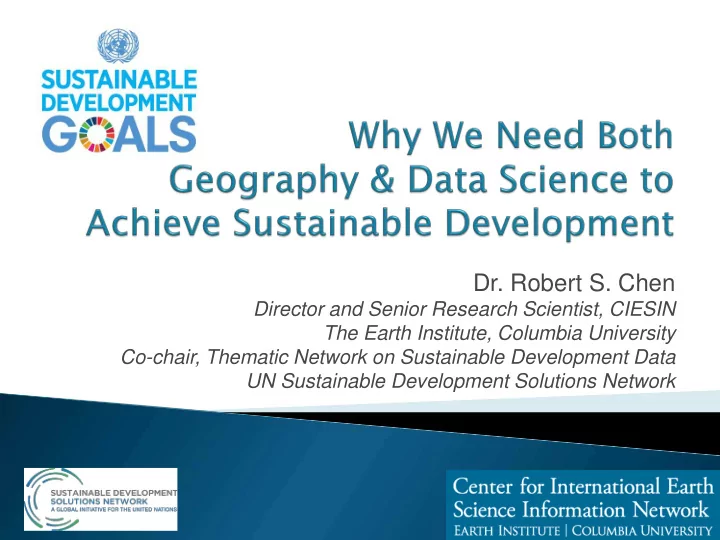

Dr. Robert S. Chen Director and Senior Research Scientist, CIESIN The Earth Institute, Columbia University Co-chair, Thematic Network on Sustainable Development Data UN Sustainable Development Solutions Network
4. As we embark on this great collective journey, we pledge that no one will be left behind . Recognizing that the dignity of the human person is fundamental, we wish to see the Goals and targets met for all nations and peoples and for all segments of society . And we will endeavour to reach the furthest behind first . 48. Indicators are being developed to assist this work. Quality, accessible, timely and reliable disaggregated data will be needed to help with the measurement of progress and to ensure that no one is left behind. Such data is key to decision-making. 17.18 By 2020, enhance capacity-building support to developing countries, including for least developed countries and small island developing States, to increase significantly the availability of high- quality, timely and reliable data disaggregated by income, gender, age, race, ethnicity, migratory status, disability, geographic location and other characteristics relevant in national contexts (emphasis added) https://sustainabledevelopment.un.org/ post2015/transformingourworld
The data revolution is already happening: ◦ New technologies leading to exponential increase in volume and types of data available ◦ Much greater demand for data from all sides ◦ Governments, companies, researchers and citizen groups are in a ferment of experimentation, innovation and adaptation A huge opportunity to enable and accelerate sustainable development http://www.undatarevolution.org/wp-content/ uploads/2014/11/A-World-That-Counts.pdf
“Population distribution” and “Cities and Infrastructure Mapping” are important to indicators and decision making related to all 17 goals Alignments of the Goals with specific types of Earth observations and geospatial information GI-18 Initiative
GPWv1 was an outgrowth of a Global Demography Workshop held at CIESIN in 1994 Consensus that a consistent global database of population totals in raster format would be invaluable for interdisciplinary study (Deichmann et al., 2001) Produced by Waldo Tobler, Uwe Deichmann, Jon Gottsegen, and Kelly Maloy at UC-Santa Barbara Waldo Tobler, 1930-2018
GPWv4.10 now Includes new dataset on Basic Demographic with gridded estimates of population by age groups and gender for 2010 http://sedac.ciesin.columbia.edu/data/collect ion/gpw-v4/sets/browse 7
Statistic ical l / Imagery ry / Nomin inal l Prop. p. Mult ltip iple mach chine ne spe spectral Spat atial al Projec ect Dasy Da symetric Radar ar Allocatio ion Time Points learni ning data ta Resolutio ion GPW ✔ ✔ 1km Landscan La ✔ ✔ ✔ ✔ 1km World ldPop ✔ ✔ * 100m GHSL GH 30m, 250m, ✔ ✔ ✔ ✔ 1km GUF ~12m for scientific ✔ ✔ ✔ research ~84m public Esri Esr ✔ 250m HRSL ✔ 30m ✔ GMIS GM IS/HBASE ✔ ✔ 30 m * Exists for some countries, planned for WorldPop Global
High Resolution Settlement Layer (HRSL): Foc ocus us on on rur ural po popu pula latio ion t to opt ptim imiz ize Inter ernet et a acces ess Collaboration with Interne net. t.or org/Facebook ook A: Haiti; B: Sri Lanka to produce open http://ciesin.columbia.edu/data/hrsl/ access 30-m resolution population density estimates: based on high res remote sensing imagery (IKONOS) Data for 23 countries plus Puerto Rico released; others to be released soon.
Human settlements and infrastructure are a dynamic, integrated system, dependent on environmental conditions and ecological services, and managed by people! ◦ People live and work in infrastructure ◦ Households, communities invest in, expand, and maintain infrastructure ◦ Vulnerability to disaster, climate change, pollution, etc. depends on infrastructure ◦ Sustainability of infrastructure (physical, economic, social) depends on environmental conditions and ecological services, and their variability ◦ Key subsystems related to energy, water, transportation, sanitation, communications, etc. need to work together ◦ Infrastructure is a critical economic asset, essential to future income generation and sustainable development
Public-private data partnership involving intergovernmental organizations, national & academic research institutions, large and small companies, NGOs, foundations, universities, data stewards, etc. Goal: Accelerate the development and use of high quality, highly usable georeferenced data on population, human settlements, and infrastructure ,
POPGRID Web Site http://www.popgrid.org POPGRID Google Group https://groups.google.com/forum/#!forum/popgrid GEO Human Planet Initiative https://www.earthobservations.org/activity.php?id=119 GEO Symposium 2018 , June 11-12, 2018, Geneva, Switzerland UN World Data Forum , October 22-24, 2018, Robert Chen Dubai, UAE bchen@ciesin.columbia.edu GEO XVI Plenary , October 29-November 1, gyetman@ciesin.columbia.edu 2018, Kyoto, Japan CIESIN: International Data Week , November 5-8, 2018, http://www.ciesin.columbia.edu Gaborone, Botswana SEDAC: American Geophysical Union , December 10- http://sedac.ciesin.columbia.edu 14, 2018, Washington DC
Recommend
More recommend